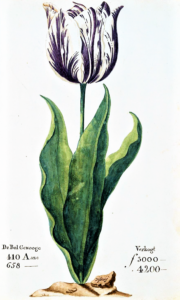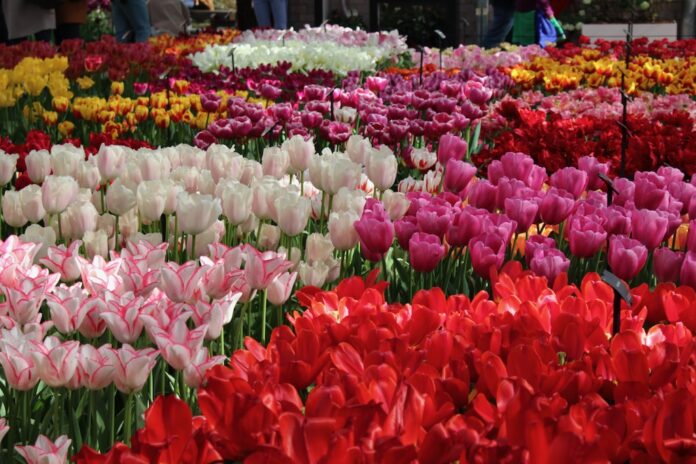The Netherlands and the tulips are almost metonyms. No tourist goes back without one of those tulip souvenirs. It’s simply a must-do! And with spring, tulips take over the Netherlands landscape.
The Dutch have cultivated almost unrivalled amounts of flowers for centuries and currently produce around three billion tulip bulbs every year.
Tulips are bulbous plants that belong to the Lily family. Seventy-five species in all, the word tulip means turban in Persian. Despite their synonymity with the Netherlands and Dutch horticulture, tulips originated in the Middle East and only started appearing in western Europe after the end of the Medieval period. The Dutch gradually perfected Tulips into a highly marketable commodity.
Tulips were cultivated in Constantinople as early as 1055. By the 15th century, tulips were among the most prized flowers, becoming the symbol of the Ottomans. These iconic flowers were introduced to the Netherlands during the mid-16th century. Western diplomats to the Ottoman court observed and reported on them, and they were rapidly introduced into Europe and became a much sought-after commodity during tulip mania. Tulips were frequently depicted in Dutch Golden Age paintings and have become associated with the Netherlands.
The story of Tulips is not complete without the role of botanist Carolus Clusius. He planted tulips in both a teaching garden and his private garden in late 1593. These tulips at Leiden would eventually lead to both the tulip mania and the tulip industry in the Netherlands. In 1596 his garden was robbed for the tulips.
Tulip mania
Tulip mania was a period during the Dutch Golden Age when prices of tulips reached extraordinarily high levels. The popularity soared from 1596 to 1637. The major acceleration started in 1634 and then dramatically collapsed in February 1637. It is generally considered to have been the first recorded speculative bubble or asset bubble in history. At the peak of tulip mania, in February 1637, some single tulip bulbs sold for more than ten times the annual income of a skilled artisan. The two remarkable species of tulips sold for whopping figures during the tulip mania are recognised as Viceroy and Semper Augustus.

Semper Augustus” was the most expensive tulip during the 17th-century tulip mania. “The colour is white, with Carmine on a blue base, and with an unbroken flame right to the top” – wrote Nicolas van Wassenaer in 1624 after seeing the tulip in the garden of one Dr Adriaen Pauw, a director of the new East India Company. The Viceroy sold for 3000 to 4000 guilders at the peak of Tulip mania. These expensive variations were characteristic of a broken pattern. The flowers looked like their primary colour was streaked with white or yellow. Interestingly, a botanist Dorothy Cayley found the cause of this pattern to be a virus.
Tulipicious
It’s a little-known fact that tulips are edible. The tradition of eating tulip bulbs and petals was born out of Dutch pragmatism during times of famine in the last year of World War II. During the German occupation, a harsh winter fell upon the Netherlands in 1944-45. Farming restrictions and strict food rations forced the Dutch to find nutrition in the tulip bulbs, which were both available and energy-rich. Thus tulip soup, tulip bread and tulip balls were found in recipes in local magazines.
Although the origins of eating tulips hark back to a dark time in history, today, eating tulip bulbs and their flowers is a way of celebrating the harvest season. The tulips are a member of the allium family, such as onion and garlic. Tulips can add a mild flavour and a crunchy texture to a dish. Celery and cucumber pair well with tulips in a salad. You can also add tulips to foods like tuna salad. You can spruce up your cocktails with tulips. The wonder petals can be great ice cream garnishes too. Consider filling an opened bloom with ice cream! Sarah Buckley, a botanist and food blogger, recommends adding lavender honey or basil ice cream in the centre of the tulip flower and sprinkling some candied tulip petals onto the ice cream scoops. Behold! A spring stunner at Easter or a mother’s day treat.
A note of caution
If you decide to chomp on the tulips, take care to remove the bitter and poisonous yellow core. Tulip bulbs are usually heavily sprayed with pesticides, so make sure to buy organic bulbs. Occasionally, a Tulip itch or rash has been observed with mild allergic symptoms such as a runny nose and sometimes along with mild gastrointestinal allergic symptoms.











